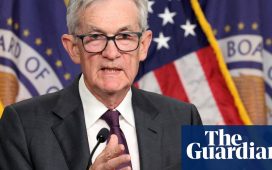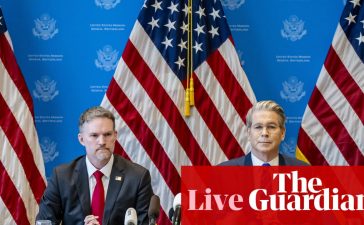Ever since the era of post-cold war globalisation began, a succession of shocks have provoked dark prophecies of its demise. The 9/11 attacks, the global financial crisis, Covid lockdowns, Russia’s invasion of Ukraine: each brought fears that sand would clog the wheels of global trade.
Each time the system has survived and even thrived. Supply chains have continued to encircle the world, while digital technology has paved the way for new forms of globalisation.
Global trade now faces its biggest challenge yet, the great-power rivalry between the US and China. In a speech in 2019, the former Australian Prime Minister Kevin Rudd laid out the risks of reducing economic links between the two countries. A “fully decoupled world”, he said, would “[undermine] the global economic growth assumptions of the last 40 years, heralding the return of an iron curtain between East and West.”
Five years on, the US-China contest is now posing a genuine threat to globalisation. Beijing and Washington are using subsidies, tariffs and export controls to compete for critical minerals and technological advantage in sectors from semiconductors, clean energy and telecoms to electric vehicles, AI and quantum computing.
The new economic nationalism

With globalisation on the retreat, the FT investigates the causes and consequences of this new era of greater state intervention in the economy
Part 1: How national security has transformed economic policy
Part 2: China’s new back doors into western markets
Part 3: Can globalisation survive the US-China rift?
“These are troubling times for global trade,” Ngozi Okonjo-Iweala, director-general of the World Trade Organization, said in July. “Amid geopolitical tensions and the backdrop of the climate crisis, we see increased protectionism.” She added that after years of talk about decoupling, “trade may be starting to fragment along geopolitical lines”.
Policymakers in the US now feel pressure to be ever more hawkish and cut economic ties. “No one with ambition wants to be in the dovish half of those talking about policy directed towards China,” according to Larry Summers, US Treasury secretary from 1999-2001. “And that creates a potentially very, very dangerous dynamic.”
Fresh cracks are appearing in the global economy, as the plumbing that underpins global trade — the networks carrying cargo, commodities and information — increasingly becomes politicised.
Yet despite these political pressures, global trade has so far proved surprisingly resilient. A number of studies have emphasised that even with the protectionist shift in the US and tariff wars with China, the evidence of a fundamental fracturing in investment and trade is tentative.
After dividing countries into two geopolitical blocs centred on the US and China, WTO economists estimate that since Russia’s invasion of Ukraine, goods trade has grown by only 4.2 per cent less between blocs than within them. IMF studies also find relatively less trade and foreign direct investment between geopolitical blocs than within them, but describe the differences so far as relatively small.
“How gloomy you are about globalisation depends very much on what measure you look at,” says Simon Evenett, professor of geopolitics and strategy at the IMD Business School in Switzerland. Global goods trade has recovered from the Covid shock, and cross-border data flows and services, particularly digitally enabled services, have been performing well.
That resilience is down to two factors: the fluid adaptability of multinational companies and the pragmatic governments that have declined, so far, to take sides. Defying the growing geopolitical turbulence in the system, a number of countries, especially middle-income economies, have provided ballast against further instability.
“Different from the early years of the cold war, a set of non-aligned connector countries are rapidly gaining importance and serving as a bridge between blocs,” the IMF research concluded. “The emergence of connectors has likely brought resilience to global trade and activity.”
Given increasing tensions between Washington and Beijing, the question arises: how much longer can this cluster of largely non-aligned countries hold the centre together?
At present, the great-power rivalry is taking the form of lower-level conflict in a variety of strategically important sectors.
One long-running battle is over 5G mobile technology, where the US has pressed allies to exclude the Chinese producer Huawei from networks over fears about potential espionage, with mixed success. Australia and Japan banned Huawei completely. The UK, initially enthusiastic about Huawei, did an about-turn and followed suit, though with a long deadline of 2027. EU member states and Asian countries have allowed its kit into their systems to varying degrees.

Electric vehicles is another source of tension. Through massive subsidies and tariffs, Joe Biden’s administration has attempted to create a largely standalone North American EV market. Last week Canada bowed to diplomatic pressure from Washington and announced it would match the US’s 100 per cent tariffs on Chinese EVs.
Critical materials are a third arena of sparring. The green transition has created a geopolitically-charged scramble to secure supplies including rare earths, lithium and nickel. China has been the most aggressive and well-equipped in the battle.
Indonesia, for example, is the world’s largest source of nickel. Canadian investors were the first foreigners to extract deposits, but China had the capacity to invest heavily in processing and refining, and then bought the finished product. The US is now countering in the battle for influence by offering tax breaks for Indonesian nickel as long as Chinese companies do not control its production.
Beijing also uses export controls to strengthen its position. Last July, China announced restrictions on sales of gallium and germanium, rare minerals used in semiconductors, followed by sharp rises in global prices.
The EU has weaker instruments than Beijing or Washington, but has signed minerals supply agreements with exporting countries, including a recent deal with Serbia. In the case of Chile, a lithium producer, Brussels sought to buy the government’s goodwill by tweaking a trade deal to allow some of the metal to be sold cheaply in-country to encourage domestic processing.

But market forces and pragmatic governments remain powerful forces against fragmentation.
Trading powers are hedging bets and making decisions issue by issue. On electric vehicles, for example, the EU wants to collaborate with China’s manufacturers rather then repel them as the US has. It has put much lower temporary import tariffs on Chinese EVs and is encouraging Chinese companies to set up production in Europe. Middle-income countries — Brazil and Turkey — often actively court Chinese EV investment.
Recently, several middle-income countries — India, Indonesia and Brazil — have put tariffs on imports from China in sectors like steel and textiles while remaining integrated with Chinese-dominated supply chains for other goods. Australia, though a strong US foreign policy ally, has resumed coal sales to China after Beijing lifted a block on its exports.
As for critical minerals, permanently cornering supply of a commodity is hard, especially those with high levels of volatility. The global scramble for lithium has caused supply to increase and prices to plunge, and stimulated research into rival sodium-ion batteries. Nickel prices have also crashed, making China’s activities in Indonesia less pivotal.
Jack Bedder, director of the critical materials market intelligence company Project Blue, notes that Beijing’s export restrictions on gallium have been followed by rapid increases in both gallium production in China and exports from Vietnam, suggesting Chinese producers could be evading controls. “At a national level they may be interested in geopolitical rhetoric between Beijing and Washington,” Bedder says. “At a local level they are more interested in job creation.”
The power of market forces also resists disintegration of supply chains. Ryan Petersen, chief executive of the freight forwarding company Flexport, says the industry is learning to adapt to geopolitical changes. “Being ready for whatever change comes is more valuable than trying to be a better [political] predictor,” he says.
Countries like Mexico and Vietnam have become intermediaries between the US and China, potentially reducing efficiency but keeping supply routes viable. US imports from China have plunged, but those from countries themselves dependent on Chinese-made inputs have risen.
“There will be more duplication of supply chains,” says Emily Kilcrease, senior fellow at the Center for a New American Security think-tank. “But it’s possible that means more competition and so could be a good thing.”
The other sphere where US-China tensions are playing out is over the infrastructure that binds the global economy together. The once relatively neutral networks for trade and communications — shipping waterways, oil and gas pipelines, undersea data cables and satellites — have become engulfed in politics.
“Governments are increasingly recognising that security stretches from the bottom of the sea to the top of the skies,” says Adrian Cox of Deutsche Bank. “The infrastructure around the global economy’s weak points is typically remote, cross-border, physically fragile, hard to access and hard to repair, and with very little regulatory or legal oversight.”
For communications under the sea and in space, governments are increasingly reluctant to rely on hostile foreign countries and fickle private companies. The upside is that, as with duplicate supply chains, building multiple communications systems can create spare capacity and resilience.
Submarine optical fibre cables act as the global arteries of the internet. The thickness of a garden hose, there are more than 400 cable systems covering 1.4mn km, most of which lie exposed on the sea floor. There have long been concerns about cables being hacked or damaged. But when they are cut accidentally by ship’s anchors, data providers have been able to maintain service via packet switching to other routes.
The threat from geopolitical rivalry is more fundamental. A research report from the Hinrich Foundation think-tank says the undersea cable-scape is bifurcating into American and Chinese spheres of influence. “The development of the global undersea cable network is one example of a world where geopolitical imperatives are creating dual technology stacks,” says Alex Capri, the report’s author and a lecturer at the National University of Singapore’s business school.

Private companies including Google and Microsoft are taking over the business of laying and maintaining cables. But they are under intense pressure from the US government not to do business with Chinese companies like HMN Technologies, previously owned by Huawei.
One of the world’s biggest cable projects is the $600mn south-east Asia-Middle East-Western Europe 6 (Sea-Me-We 6) system from Singapore to France, passing through countries such as Malaysia, India and Pakistan. Under intense diplomatic pressure from the US, governments along the route chose the American company SubCom to build the cable over China’s HMN Tech.
Two of China’s biggest telecom groups, China Telecom and China Mobile, then withdrew from the project. Still, HMN Tech and other Chinese partners are building a rival Peace cable system along similar routes, meaning that there are two communications links rather than one.
Satellite systems are also being politicised and duplicated. For decades the world relied on the US Global Positioning System (GPS) for positioning, but China (Beidou), the EU (Galileo) and Russia (Glonass) have now built their own, with Japan and India also creating systems to cover their respective regions. The Indian project was spurred by the US denying India access to GPS during the Kargil conflict with Pakistan in Kashmir in 1999.
For data-link satellites which provide internet connections, governments no longer want to be so dependent on Starlink, run by Elon Musk. In the US, Amazon is building a mega-constellation system called Kuiper. China has three separate systems in development: the first batch of satellites for the state-backed Qianfan (Spacesail) system was launched in August.
“The question [of satellite systems] goes deep into long-term geopolitical strategies,” says Antoine Grenier, partner at the consultancy Analysys Mason. “Building [one] is like creating a reserve army — it’s expensive and you might not need it but it’s within your control and more secure.”

Those satellite systems, he says, cost tens of billions every few years, a premium very likely worth paying. Middle powers will have to use devices and systems compatible with multiple providers, not an efficient outcome but a relatively robust one.
The EU has edged towards creating its own fleet of satellites, IRIS², but it’s been snarled up in wearily familiar intra-European politics. Germany says the project is too expensive and influenced by French aerospace interests. “Europe is currently going through a soul-searching journey with IRIS²,” Grenier says. “It is not there yet.”
As the US-China rivalry intensifies, existing systems of governance are coming under intense strain. Can governments still work together to enforce rules that prevent the system from fragmenting? Or are they actually accelerating it by creating standalone trading blocs?
The short answer: probably neither. Multilateralism is weak. The US is undermining the WTO by citing a national security loophole to break rules at will. The EU won a case against Indonesia over its nickel export ban, but the WTO’s dysfunctional dispute settlement system has delayed compliance.
But this does not mean regional or geopolitical trading blocs will start setting the rules of trade instead. The US talks a good game about building alliances, but the political toxicity of trade deals in Washington stops it offering market access to incentivise countries to join. The Indo-Pacific Economic Framework, the US’s main initiative in the Asia-Pacific, is widely regarded as all stick and no carrot.

There are more informal groupings including the US-dominated G7 of rich nations and the China-led Brics (whose original members were Brazil, Russia, India, China, South Africa) of middle-income countries. But outside some specific issues like the G7’s sanctions on Russia they cannot find enough consensus to take collective action.
On the raw materials issue, like-minded advanced economies have created a 15-member critical minerals partnership, to try to ensure supply. But Bedder of Project Blue says there is little evidence yet of a significant effect.
The medium-term future for globalisation seems set: a struggle between Washington and Beijing for pre-eminence, or at least resilience, which continually threatens to override economic efficiency with national security.
The counterweight will come from geopolitical agnosticism among other governments and the endlessly inventive supply-chain managers of multinationals. Those countervailing liberalising pressures have won in the past. But the centrifugal forces pulling the trading system apart are by far their fiercest opponent yet.
Cartography by Chris Campbell and data visualisation by Keith Fray










